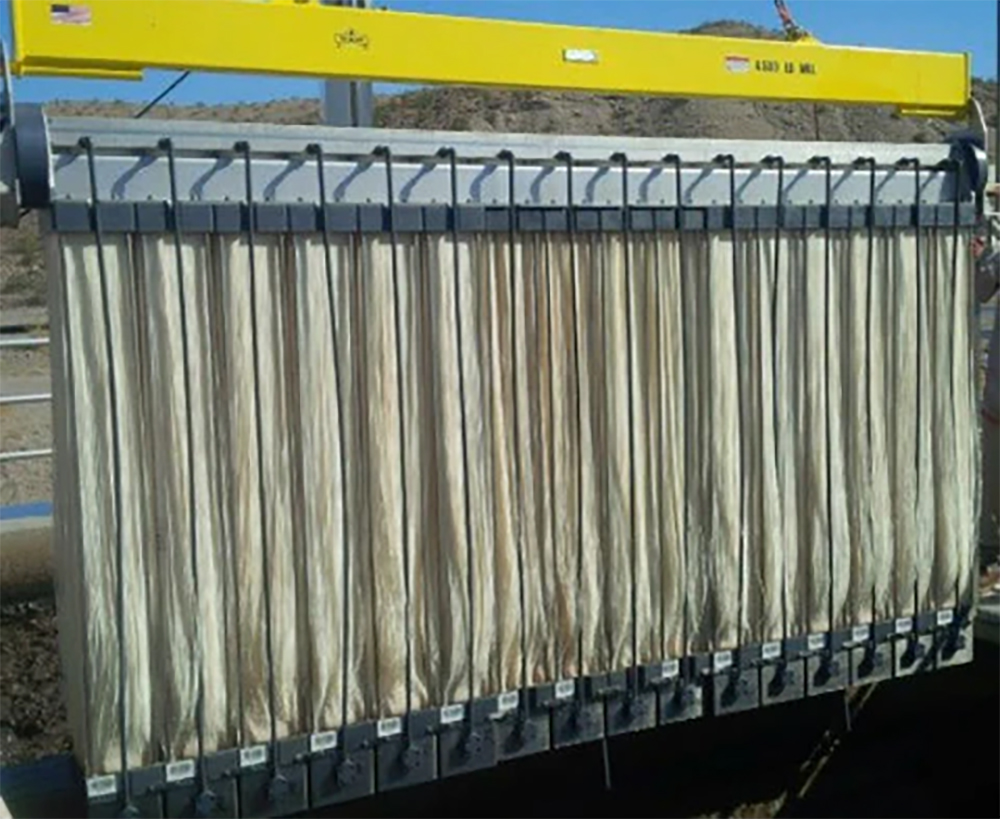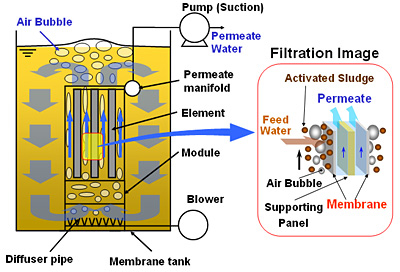Membrane Bioreactor as a Sustainable Solution for High-Volume Wastewater Treatment
Membrane Bioreactor as a Sustainable Solution for High-Volume Wastewater Treatment
Blog Article
Just How Membrane Layer Bioreactors Are Reinventing Water Purification Systems
The appearance of membrane bioreactors (MBRs) represents a substantial improvement in the area of water filtration, combining organic therapy processes with cutting-edge membrane filtration innovations. As international water shortage magnifies, the duty of MBRs in helping with drinkable water reuse and sustainable water management becomes significantly important.
Summary of Membrane Bioreactors
Membrane bioreactors (MBRs) stand for a considerable advancement in water filtration technology, as they integrate organic treatment procedures with membrane layer filtration. This assimilation improves the performance of wastewater therapy by making use of bacteria to break down organic pollutants while at the same time using semi-permeable membranes to separate treated water from put on hold pathogens and solids.
The MBR system commonly includes a biological activator where the microbial population metabolizes impurities, complied with by a membrane layer purification system that preserves biomass and allows only clean water to go through. This double capability leads to higher effluent quality compared to standard treatment methods. MBRs can be operated in both set and constant circulation settings, offering versatility in style and application.
Furthermore, MBRs are identified by their compact impact, making them ideal for city settings with area restraints. Membrane Bioreactor. They also make it possible for the recuperation of water for reuse, hence adding to water sustainability efforts. While MBR modern technology has actually gained popularity in community and industrial applications, its functional complexities and energy demands necessitate careful factor to consider during implementation. Overall, MBRs go to the forefront of improving water therapy efficiency and high quality, showcasing the potential for innovative solutions in environmental administration.
Advantages of MBR Technology
The combination of biological therapy with membrane layer purification supplies numerous advantages for water filtration processes. One of the main benefits of Membrane Bioreactor (MBR) innovation is its capability to effectively remove both not natural and organic impurities, bring about high-quality effluent. The membranes function as a physical barrier, avoiding suspended solids and pathogens from passing through, which improves the overall safety and security and reliability of treated water.
Additionally, MBR systems need a smaller impact compared to traditional therapy approaches, enabling a lot more efficient space use. This compact layout is specifically beneficial in city setups where land is restricted. MBRs also demonstrate operational versatility, accommodating differing influent top qualities and flow rates without considerable efficiency degradation.
In addition, the process offers boosted nutrient elimination capacities, particularly for nitrogen and phosphorus, which are crucial for protecting against eutrophication in getting waters. The decreased sludge production related to MBR innovation also equates to decrease disposal expenses, making it a cost-efficient service over time - Membrane Bioreactor. On the whole, the benefits of MBR innovation placement it as a leading option for innovative and sustainable water filtration systems, addressing both environmental and economic worries
Applications in Water Purification
Applications of Membrane Layer Bioreactor (MBR) modern technology in water purification are impactful and varied, dealing with numerous therapy requires across multiple sectors. MBRs properly integrate organic treatment processes with membrane filtering, making them optimal for community wastewater therapy, commercial effluent administration, and also drinkable water reuse campaigns.
In local settings, MBRs are increasingly utilized to improve the quality of dealt with wastewater, enabling conformity with stringent discharge policies and promoting the recycling of water for watering and non-potable usages. Their portable style likewise makes them ideal for urban settings where space is limited.
Industrially, MBR innovation is utilized to treat process water and wastewater, especially in industries such as food and drink, drugs, and textiles. By properly getting rid of contaminants and suspended solids, MBRs assist industries decrease ecological impacts while recouping important sources from wastewater streams.
In Addition, MBRs are gaining grip in decentralized water therapy applications, where small systems can be released in remote areas or establishing regions. This flexibility allows areas to achieve sustainable water monitoring options, enhancing accessibility to clean water while decreasing reliance on traditional treatment techniques.
Study and Success Stories

In one more example, a fabric click for more production facility in Bangladesh took on MBR technology to address its wastewater difficulties. The system lowered chemical oxygen demand (COD) levels from 1,200 mg/L to less than 100 mg/L, hence fulfilling governing criteria and significantly reducing environmental impact.
The University of Cape Town's MBR installment has actually shown reliable in dealing with greywater for non-potable reuse on university. This job not only saves potable water however additionally works as an educational version for sustainable methods.
Furthermore, a fish and shellfish processing plant in Norway utilized MBR modern technology to treat effluents including high levels of natural issue, attaining over 90% pollutant elimination. These study emphasize MBR modern technology's adaptability and its vital function in boosting water quality throughout varied applications.
Future of Water Therapy Solutions
As international water shortage and pollution difficulties intensify, cutting-edge water therapy solutions are coming to be increasingly crucial to guarantee lasting access to tidy water. The future of water therapy depends on the integration of sophisticated modern technologies that improve the performance and effectiveness of purification procedures. Membrane layer bioreactors (MBRs) are at the center of this advancement, combining biological treatment with membrane filtration to generate premium effluent suitable for various applications.

Arising fads such as source recuperation from wastewater, consisting of nutrients and energy, will certainly even more change therapy facilities right into environmentally friendly centers. Innovations in nanotechnology and membrane layer materials assure enhanced efficiency and long life of filtering systems.

Verdict
Their duty in potable water reuse and sustainable water monitoring highlights their relevance in attending to worldwide water shortage challenges. Proceeded research study and growth will certainly better boost the efficiency and adoption of MBR technology, making sure a resistant future for water therapy services.
The emergence of membrane layer bioreactors (MBRs) stands for a substantial advancement in the area of water purification, merging organic therapy procedures with advanced membrane filtering technologies. As international water shortage magnifies, the role of MBRs in facilitating drinkable water reuse and sustainable water monitoring becomes increasingly crucial. They additionally allow the recovery of water for reuse, therefore contributing to water sustainability initiatives.As worldwide water deficiency and pollution difficulties heighten, innovative water treatment options are coming to be increasingly vital to make certain sustainable accessibility to tidy water. Their duty in potable water reuse and sustainable water monitoring highlights their importance in attending to international water shortage obstacles.
Report this page